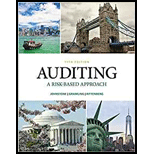
a.
Introduction: Sampling is the technique of selecting a smaller portion for a large population for the purpose of statistical analysis or research. There are various methods of selecting a sample depend upon the type of analysis or research.
The
b.
Introduction: Sampling is the technique of selecting a smaller portion for a large population for the purpose of statistical analysis or research. There are various methods of selecting a sample depend upon the type of analysis or research.
To calculate: The type of opinion given to the client internal controls.
c.
Introduction: Sampling is the technique of selecting a smaller portion for a large population for the purpose of statistical analysis or research. There are various methods of selecting a sample depend upon the type of analysis or research.
The potential misstatement from the control deviation.
d.
Introduction: Sampling is the technique of selecting a smaller portion for a large population for the purpose of statistical analysis or research. There are various methods of selecting a sample depend upon the type of analysis or research.
The substantive
Trending nowThis is a popular solution!

Chapter 8 Solutions
Bundle: Auditing: A Risk Based-approach, 11th + Mindtap Accounting, 1 Term (6 Months) Printed Access Card
- What is the net income percentage ?arrow_forwardCan you please answer the financial accounting question?arrow_forwardidentify the key factors that contributed to the collapse of Northern Rock bank. Compile documents and analysis of regulations (magazine articles, newspapers, online sources, working papers from different organizations, activity summaries, results reports, legal regulations, speeches, public statements, press conferences, etc.). Apply, in a practical and theoretical way, what has been learned in class about the financial world, regulation and risk management.arrow_forward
 Auditing: A Risk Based-Approach (MindTap Course L...AccountingISBN:9781337619455Author:Karla M Johnstone, Audrey A. Gramling, Larry E. RittenbergPublisher:Cengage Learning
Auditing: A Risk Based-Approach (MindTap Course L...AccountingISBN:9781337619455Author:Karla M Johnstone, Audrey A. Gramling, Larry E. RittenbergPublisher:Cengage Learning Auditing: A Risk Based-Approach to Conducting a Q...AccountingISBN:9781305080577Author:Karla M Johnstone, Audrey A. Gramling, Larry E. RittenbergPublisher:South-Western College Pub
Auditing: A Risk Based-Approach to Conducting a Q...AccountingISBN:9781305080577Author:Karla M Johnstone, Audrey A. Gramling, Larry E. RittenbergPublisher:South-Western College Pub

